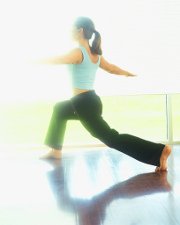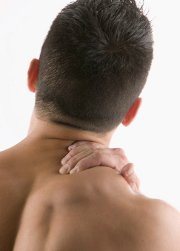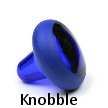Gentle Self Massage:
Trigger Point Pressure Release
In my never-ending quest to find the "perfect" self massage technique, I discovered that the more aggressive deep stroking massage technique did not work on everyone; there were some areas where they just couldn't tolerate it. I found that on myself, it would not get rid of a SCM (sternocleidomastoid) headache because it would just create waves of pain and guarding in the muscle. I then tried backing off the pressure from aiming for a 7/10 to a 4 or 5/10 on a 0 - 10 pain scale, but this was still not gentle enough in some cases. So I tried another method called Trigger Point Pressure Release. Here is a summary of how I teach this to patients and use it on myself.
Self Massage: Trigger Point Pressure Release
|
|
1. Lengthen muscle to the point of resistance

This is probably the hardest part in the whole self massage procedure, since you have to know which way to stretch it. The release will still work without a stretch, though not as optimally. One way to figure it out, is stretch the area in different ways until you feel the pain or tightness you are trying to get rid of. (Remember, the pain is not at the location of the trigger point 70% of the time. Refer to a manual such as The Trigger Point Therapy Workbook by Clair Davies.) Then back off till there is no pain, and apply the gentle pressure on the trigger point. I have a patient that discovered that this method could be used on the spot to stretch further in yoga!
2. Gradually apply pressure until you feel a resistance (discomfort) in the muscle
What we are looking for in this step is to find the "barrier" which can be slightly challenging for a beginner. Think of it this way: if you have a very soft pillow on a firm bed, push through the pillow until you reach the bed, but not into it. In the same way, you will push into the tissue through the soft part, but not into the firm part of the muscle. This is usually where you first start to feel discomfort, but not pain. It is important not to stimulate pain, because this can prevent the muscle tissues from softening.
3. Hold pressure until the resistance/discomfort fades
This should happen in 5 to 30 seconds, sometimes up to a whole minute. If it lasts longer, it usually means you are pushing too hard. I often use the discomfort as a marker, since it is easier for patients to relate to. Around the same time that the discomfort fades, the trigger point will soften and you can apply more pressure. You may want to use a massage tool for self massage because holding this pressure can be hard on your thumb over time, or you may not be able to reach the area.

4. Increase pressure again to the resistance (discomfort)
Again, use the same guidelines as above. Engage the barrier, but don't cause pain.
5. Repeat process 3-4 times per trigger point
Sometimes I will do more repetitions if it is a very large or deep trigger point, but usually, I will stick to 3-4 repetitions. You can push in the same direction each time to get deeper, or you can vary your angle to get different aspects to the trigger point. Both are helpful depending on what the muscle needs.
6. Repeat on all trigger points in the muscle
Make sure to scan the whole muscle for other trigger points, because they can re-activate the trigger point you just worked on. You should also check the opposing muscles as well, since they often will be affected in a set.
7. Work each trigger point 3-6 times per day
If I have learned one thing about self massage, it is that persistence and consistency are key to conquering muscle pain. Once you have figured out where the trigger points are, keep working them consistently until they go away. This can take one day to several months. You should see some changes happening in about 2 weeks.
Conclusions about Self Massage
As I mentioned above, the biggest key is persistence, but accuracy is important too. Make sure you are working the right trigger points. A manual such as The Trigger Point Therapy Workbook by Clair Davies is an important tool in figuring this out. The Trigger Point Pressure Release Method has the advantage over Deep Stroking Massage in that it doesn't hurt. However, if it does not work for you, there could be several reasons:

Too Much Pressure — You might be pushing too hard, creating pain and guarding in the muscle.
Too Little Pressure — Maybe you are not pushing hard enough to reach the barrier, or maybe your body would respond better to Deep Stroking Massage.
Trigger Point too Irritated for Self Massage — In this case, any additional pressure is too much for the trigger point. A better method for a hyper irritated trigger point is ice and stretch.
Perpetuating Factors — If you seem to get some relief, but the trigger points keep coming back, there may be other primary trigger points that are re-creating the ones you are treating. The other possibility is that you may be dehydrated, using the muscle in a way that is aggravating it (like poor posture), or not taking in the proper vitamins and minerals that you need.
Free PDF Summary for Professionals
You will need Adobe Reader (the latest version is recommended) installed on your computer in order to open and read this summary. You can get Adobe Reader here (a new window will open so you can download it without leaving this page).
If you want to open the file in your browser window, just click on the link. However, if you want to download the file to view later, then right-click on the link and choose "Save Target As" or "Save File As." Then select where you want to save the file on your hard drive.